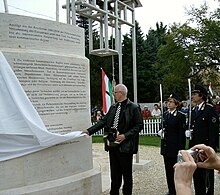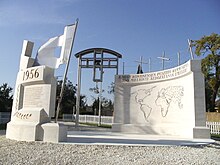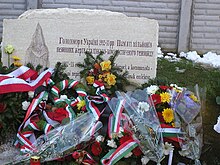Gloria Victis Memorial
The Gloria Victis Memorial was built on the 50th anniversary of the 1956 Hungarian uprising in honor of the 100 million victims of world communism . It is located in the large municipality of Csömör , on the north-eastern outskirts of Budapest .
inauguration

At the inauguration of the first memorial with this topic in October 2006, in addition to many foreign guests and anti-communists important to Hungary, such as B. László Tőkés also a delegation of the German "Federal Foundation for the coming to terms with the SED dictatorship" under the direction of Rainer Eppelmann , the federal chairman of the East Prussian Landsmannschaft, Wilhelm von Gottberg and a small delegation from the IGMH Mannheim. Viktor Orbán was the patron of the inauguration ceremony .
description
The central part of the memorial is the twin monument. It is the work of the Gödöllő sculptor János Víg . The memorial, made of Turkish limestone on behalf of the non-profit foundation Gloria Victis , was built with public donations and with the help of the mayor's office of the large community of Csömör. It consists of the following two main parts:
An arched wall ("world wall") to represent the dimensions of the devastation of communism on four continents. This is supplemented by an irregular barbed wire fence, symbolizing the inhuman conditions of the camp, the steel crosses attached to the wall symbolically for the victims and a bell tower attached to the masonry. On the back of the arched wall you can read extracts in three languages (Hungarian, English, German) from Resolution No. 1481 of the Parliamentary Assembly of the Council of Europe of January 25, 2006 on the "Necessity of an international condemnation of the crimes of totalitarian communist regimes".
Opposite this world wall is the arched monument of the 1956 revolution in the form of a “flagship”, which - if only for a short time, but with lasting effects - put a stop to communism. The oblique representation of the Christian cross symbol chosen here indicates that Hungary took on the cross of the fight against inhuman ideology in 1956. The revolution flag rises out of this area and made of stainless steel. Instead of the communist coat of arms, however, it has a hole in the middle.
In addition to a Holodomor memorial stone, the memorial also includes a Hungarian-Polish memorial plaque commemorating the mass murder of Polish officers in Katyn , as well as a plaque commemorating the numerous Jewish and Roma victims of communism and a memorial plaque commemorating Hitler -Stalin Pact .
Words of appreciation
“I very much appreciate that you are pointing out the immeasurable suffering of these victims.” - Alois Hereditary Prince of Lichtenstein
"In an effort to come to terms with the time of the socialist and communist dictatorships in the former Eastern Bloc states and to present them objectively, many Thuringian citizens and the Thuringian state government are in agreement with you." - Thuringian State Chancellery
"The Landsmannschaft Ostpreußen considers the establishment of such a memorial to be urgently necessary." - Landsmannschaft Ostpreußen
“The Lower Saxony state government welcomes the aim of your project to commemorate the victims of communism. It is necessary that the people who are disadvantaged by the communism system are properly recognized for their commitment to freedom and democracy. ”- Lower Saxony State Chancellery
"I consider the proclamation of the representatives of all civic organizations in the community of Csömör, which refers to both totalitarian dictatorships of the 20th century, to be an important contribution to coming to terms with the past." - Roland Koch, then Prime Minister of Hesse
“Your commitment to the memory of the victims of world communism is a very important task. A memorial is certainly a very good and appropriate form to prevent forgetting and solemnly commemorate the victims. ”- Senate Chancellery of the Free and Hanseatic City of Hamburg
"We hope that the members of the Board of Trustees of the Gloria Victis Foundation have the strength and the patience to continue this work in the long term." - Foundation for the coming to terms with the SED dictatorship, Berlin
“We know very well that we have found people again in Hungary who know very well that communism must be fought at all times - but the population must also be educated. The monument will undoubtedly contribute very well to this. ”- Association of Politically Persecuted People of Communism eV, Langenhagen headquarters
“Our common Europe only has a future if it is aware of its often dark past and the importance of justice and freedom. I am therefore sure that this memorial will make a substantial contribution to coming to terms with the communist dictatorships. ”- Ms. Benita Ferrero-Waldner, then EU Commissioner for External Relations
Individual evidence
- ↑ A memorial for 100 million dead (PDF; 283 kB). Idea . 48/2006.
- ↑ In the Hungarian sea of flags. Preussische Allgemeine Zeitung, November 4, 2006
- ↑ Hungary does not forget. The axis of good. November 1, 2006 ( Memento of the original from February 29, 2016 in the Internet Archive ) Info: The archive link was inserted automatically and has not yet been checked. Please check the original and archive link according to the instructions and then remove this notice.
- ↑ IGMH
- ↑ fair play. Colorful. No. 49. November 30, 2006.
- ↑ Acknowledging words





